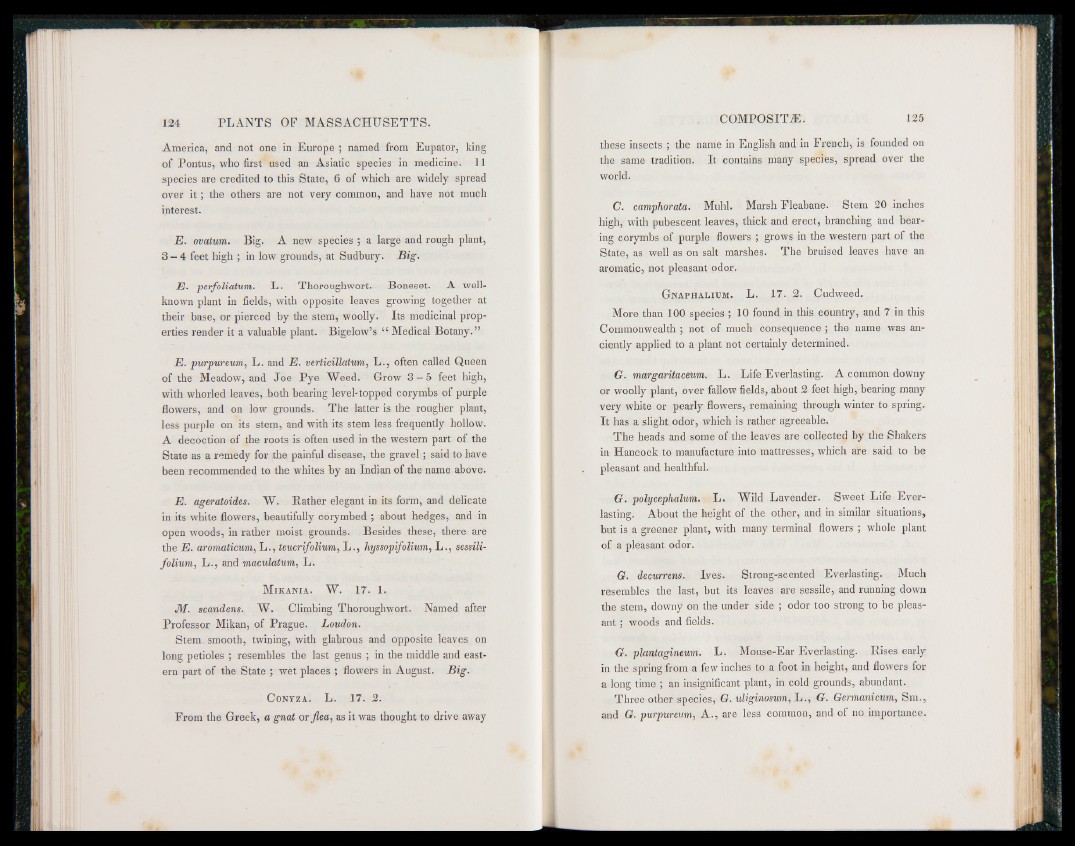
America, and not one in Europe ; named from Eupator, king
of Pontus, who first used an Asiatic species in medicine. 11
species are credited to this State, 6 of which are widely spread
over i t ; the others are not very common, and have not much
interest.
E . ovatum. Big. A new species ; a large and rough plant,
3 — 4 feet high ; in low grounds, at Sudbury. Big.
E . perfoliatum. L. Thoroughwort. Boneset. A well-
known plant in fields, with opposite leaves growing together at
their base, or pierced by the stem, woolly. Its medicinal properties
render it a valuable plant. Bigelow’s a Medical Botany.”
E. purpureum, L. and E. verticillatum, L ., often called Queen
of the Meadow, and Joe Pye Weed. Grow 3 — 5 feet high,
with whorled leaves, both bearing level-topped corymbs of purple
flowers, and on low grounds. The latter is the rougher plant,
less purple on its stem, and with its stem less frequently hollow.
A decoction of the roots is often used in the western part of the
State as a remedy for the painful disease, the gravel; said to have
been recommended to the whites by an Indian of the name above.
E. ageratoides. W. Rather elegant in its form, and delicate
in its white flowers, beautifully corymbed ; about hedges, and in
open woods, in rather moist grounds. Besides these, there are
the E. aromaticum, L ., teucrifolium, L ., hyssopifolium, L ., sessili-
folium, L ., and maculatum, L.
Mikania. W. 17. 1.
M. scandens. W. Climbing Thoroughwort. Named after
Professor Mikan, of Prague. Loudon.
Stem, smooth, twining, with glabrous and opposite leaves on
long petioles ; resembles the last genus ; in the middle and eastern
part of the State ; wet places ; flowers in August. Big.
C onyza. L. 17. 2.
From the Greek, a gnat or flea, as it was thought to drive away
these insects ; the name in English and in French, is founded on
the same tradition, It contains many species, spread over the
world.
C. camphorata. Muhl. Marsh Fleabane. Stem 20 inches
high, with pubescent leaves, thick and erect, branching and bearing
corymbs of purple flowers ; grows in the western part of the
State, as well as on salt marshes. The bruised leaves have an
aromatic, not pleasant odor.
Gnaphalium. L. 17. 2. Cudweed.
More than 100 species ; 10 found in this country, and 7 in this
Commonwealth ; not of much consequence ; the name was anciently
applied to a plant not certainly determined.
G. margaritaceum. L. Life Everlasting. A common downy
or woolly plant, over fallow fields, about 2 feet high, bearing many
very white or pearly flowers, remaining through winter to spring.
It has a slight odor, which is rather agreeable.
The heads and some of the leaves are collected by the Shakers
in Hancock to manufacture into mattresses, which are said to be
pleasant and healthful.
G. polycephalum. L. Wild Lavender. Sweet Life Everlasting.
About the height of the other, and in similar situations,
but is a greener plant, with many terminal flowers ; whole plant
of a pleasant odor.
G. decurrens. Ives. Strong-scented Everlasting. Much
resembles the last, but its leaves are sessile, and running down
the stem, downy on the under side ; odor too strong to be pleasant
; woods and fields.
G. plantagineum. L. Mouse-Ear Everlasting. Rises early
in the spring from a few inches to a foot in height, and flowers for
a long time ; an insignificant plant, in cold grounds, abundant.
Three other species, G. uliginosum, L ., G. Germanicum, Sm.,
and G. purpureum, A., are less common, and of no importance.